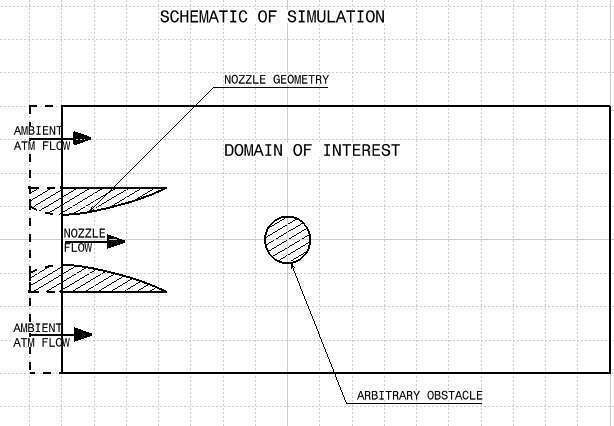The foray into space has given rise to a plethora of opportunities for technological advancement and is a potential source of addressing the questions that have been plaguing mankind since the beginning of time. However, such a venture is besieged by a number of complications owing to the drastically different flow physics encountered in rarefied atmospheres. One of the important, but, less studied, problems is that of plume impingement onto delicate surface of a space craft/satellite. The focus of this paper is divided into two major parts. Firstly, the diffusion of the multiphase exhaust plume as it exits the divergent nozzle and the change in its behaviour due to the arbitrary obstacle. Secondly, the effect on the arbitrary obstacle`s surface properties due to the impingement.
The study is a computational one and is conducted in rarefied regimes of Knudsen numbers varying from 0.1 to 1. The Navier-Stokes based CFD study in such regions has misgivings and is thus, not a preferred methodology. In this research, we utilize the widely recognized, Direct Simulation Monte Carlo (DSMC), a Kinetic particle based method. An in-house 2-D, parallel, multispecies, polyatomic solver is used for the purpose of the study. The Variable hard sphere is used for modeling the elastic part of the collisions whereas the Larsen-Borgnakke (L-B) model is used to model the inelastic portion. The continuous and discrete models of L-B are used for rotational and vibrational modes respectively. The gas surface interactions are modeled by using the Maxwell and Cercignani-Lampis-Lord (CLL) models. Adaptive cells are used to accurately model collisions in regions of high number density. Sampling is done once steady state is reached. The macroscopic values are obtained by time averaging the sampled data.
The case schematic is shown in Fig.1 and the obstacle geometry is chosen as a cylinder for illustration purposes; the study experiments with a range of obstacle geometries. The throat conditions for the nozzle flow are determined by isentropic calculations, whereas the ambient atmosphere flow is defined by the atmosphere corresponding to the degree of rarefaction considered. The nozzle flow consists of gas molecules in the primary set of runs and a mix of gas molecules and granular particles in the second set of runs. The purpose of the exercise is to capture the real world effect where the exhaust consists of solid impurities along with gases.
The variation of the plume shape due to the presence of the obstacle is captured and analyzed in the first part of the study. The various shock-shock and shock-expansion fan interactions for a given obstacle are studied and explained. The surface properties such as heat transferred, pressure variations and forces produced on various obstacles are compared and cogent statements relating the properties to the obstacle shape are presented. The effect of granules in the plume for the above cases is observed and a comparative study is presented.
References:
- A. Bird, Molecular gas dynamics and the direct simulation of gas flows, Oxford publications, 1994.
- Billig, Frederick S. "Shock-wave shapes around spherical-and cylindrical-nosed bodies."Journal of Spacecraft and Rockets 6 (1967): 822-823.
- Gray, J. M. N. T., Y-C. Tai, and S. Noelle. "Shock waves, dead zones and particle-free regions in rapid granular free-surface flows."Journal of Fluid Mechanics 491 (2003): 161-181.
- Kim, Kyu Hong, Chongam Kim, and Oh-Hyun Rho. "Methods for the accurate computations of hypersonic flows: I. AUSMPW+ scheme."Journal of Computational Physics 1 (2001): 38-80.
- Elsen, Erich, Patrick LeGresley, and Eric Darve. "Large calculation of the flow over a hypersonic vehicle using a GPU."Journal of Computational Physics24 (2008): 10148-10161.
- Scanlon, T. J., et al. "An open source, parallel DSMC code for rarefied gas flows in arbitrary geometries."Computers & Fluids 10 (2010): 2078-2089.
- Bohachevsky, Ihor O., and Ephraim L. Rubin. "A direct method for computation of nonequilibrium flows with detached shock waves."AIAA Journal 4 (1966): 600-607.
- Shang, J. S., et al. "Interaction of jet in hypersonic cross stream."AIAA journal, 3 (1989): 323-329.


